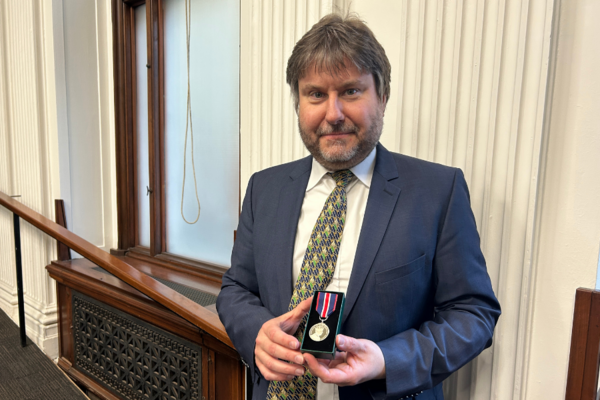Breadcrumbs
- Home
- News & events
- News
- Teacher feature: Managing projects for real-world healthcare innovation
Teacher feature: Managing projects for real-world healthcare innovation

The Translational Research Program (TRP) at the University of Toronto stands out for its unique approach. Emphasizing real-world experiences and hands-on learning, the program's teaching staff embody this philosophy. The program brings together instructors who can be full-time academics or teachers and people actively working in various relevant industries or running their own entrepreneurial activities.
Meet some of our instructors to learn why, and what, they teach as part of the TRP.
Dr. Steve Szigeti
My path to teaching project management in the TRP is a little unconventional - I didn’t start out in healthcare or even in academia. My early career was in the media and creative industries, including more than a decade at Teletoon, Canada’s all-cartoon television network.
I was originally hired in the late 1990s as a web designer at a time when many people didn’t fully understand what a website was. That role quickly grew as technology evolved, and I moved into mobile and interactive TV, taking on increasing project management responsibilities. Along the way, I began my PhD in interface design, focusing on how web designers approach complex problems.
That combination of industry experience and academic research led me into teaching. Before joining TRP, I taught project management at the University of Toronto’s Faculty of Information (the iSchool), working alongside colleagues from industry. We combined formal project management theory with the realities of how projects actually run - something I still bring into my TRP classes today.
What do you teach in the TRP and how did you get involved in the program?
When TRP was launching, founder Dr. Joseph Ferenbok - who I’d known since our PhD days -approached me about bringing both my design thinking and project management background into the curriculum. From the start, the goal was to give students practical tools to tackle complex healthcare challenges.
Today, I teach the program’s two project management modules: LMP 2340: Project Management Part I and LMP 2341: Project Management Part II. Together they provide 24 hours of instruction focused on key skills students need to complete their capstone projects - the major group projects required for graduation.
In our time together, I introduce core project management concepts like risk assessment, budgeting, team management, and progress tracking.
My aim isn’t to make students follow a rigid process, but to equip them with a toolkit they can adapt to their own needs and working styles. The ultimate goal is delivering a project as close as possible to the plan - on time, on budget, and meeting the agreed deliverables.
What is unique in your approach and how do TRP students benefit from that?
In the TRP, we learn by doing, so my online classes are structured as workshops rather than traditional lectures. I’ll introduce a concept for 20 or 30 minutes, then students break into small groups to apply it to a case study - usually one drawn from healthcare. They present their work back to the class, and I provide feedback before moving on to the next activity.
That approach keeps the learning grounded in real-world application. For example, when we cover risk assessment, students identify potential risks in a healthcare scenario, then brainstorm strategies to address them. When we talk about budgeting, they work with numbers that could realistically apply to their capstone projects.
Because TRP students come from diverse backgrounds, the classroom is enriched by their experiences. Some already have formal project management certifications, while others are encountering the discipline for the first time. Clinicians, researchers, and industry professionals all bring different perspectives, which leads to great discussions and peer learning.
Even those with considerable project management experience find value in the course. For some, it’s a useful refresher; for others, it provides the terminology and frameworks to better communicate what they already do in practice. Clinicians, for example, often find the skills directly applicable to tasks like grant writing, where defining deliverables, timelines, budgets, and team roles mirrors the process of writing a project charter.
In TRP, we know our students are balancing work, study, and personal commitments, so I structure the course with flexibility in mind. Group work is designed to be completed during our two-hour class blocks, and assignments are due several days later to allow time for those with busy schedules. Extensions are available - just like in professional life, the key is communicating before a deadline.
Whether students are new to project management or seasoned practitioners, my goal is for them to leave the course with practical tools they can apply immediately - and the confidence to manage projects of any size, in healthcare and beyond.
Tell us about an interesting or fun thing you’ve done in class recently
One of the things I enjoy most is seeing students connect what we’re doing in class to challenges they’re facing in their own work. In breakout discussions, it’s common to hear someone say, “I can use this with my team tomorrow,” or, “This will help with a conflict I’m dealing with right now.”
That immediate relevance is part of why I keep activities tied to real scenarios. For example, a recent workshop on stakeholder mapping had students identify everyone with an interest in a hypothetical healthcare project - from senior leadership to frontline staff to patients. The follow-up discussion wasn’t just about the assignment - it turned into an exchange of strategies from students’ own professional experiences.
Another unique feature is that the modules are recognized by the Project Management Institute. Students who complete both are eligible to sit for the Certified Associate in Project Management (CAPM) exam, adding a professional credential that can strengthen their CVs. While the course isn’t designed solely as certification prep, it’s a valuable option for those who want to formalize their skills.



